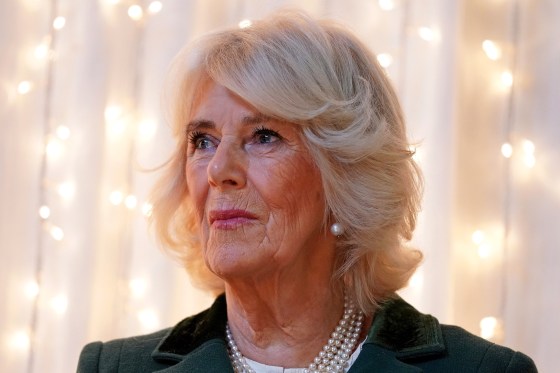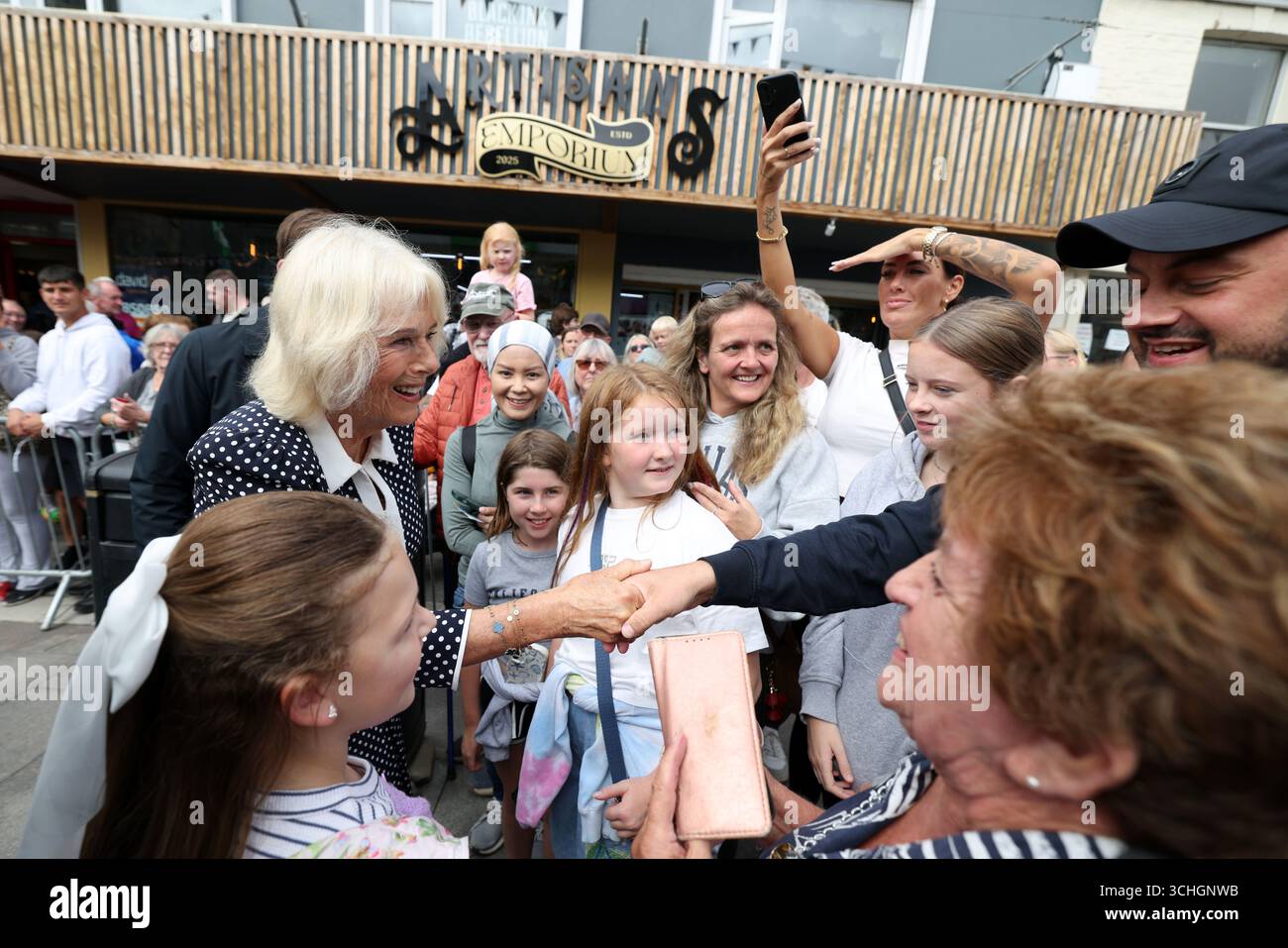:max_bytes(150000):strip_icc():focal(426x575:428x577)/Queen-Camilla-departs-from-her-visit-to-Cornwall-Air-Ambulance-090225-b9331bd15c0e44909c6302d10c919161.jpg?w=1200&resize=1200,0&ssl=1)
From Camilla’s grit to William’s quiet influence: Revelations from a new royal tell-all
Afua Hagan is a contributor to CTVNews.ca, focusing on the Royal Family. Based in London and Accra, Hagan is a regular commentator on the royals across a variety of international outlets, and is a leading voice on diversity in Britain.

In the shadowy corridors of influence where Buckingham Palace meets Downing Street, Valentine Low, writer and former royal correspondent for The Times, lifts the gilded curtain.
His new book, Power and the Palace: The Inside Story of the Monarchy and 10 Downing Street, is already stirring headlines. It promises rare access, behind-the-scenes drama, and candid revelations about the tangled relationship between the royals and Britain’s political elite.
From whispers of royal displeasure in the wake of Brexit, to unspoken tensions between public duty and private ambition, Low’s reporting offers clarity on what’s at stake. Whether you’re a constitutional aficionado, a royal-watcher, or simply curious about how power is really wielded in modern Britain, here’s everything you need to know.
A teenage Camilla defends herself

Low investigates some pivotal experiences that moulded key Royal Family members, but one that stands out and is making waves is a compelling account involving Queen Camilla.
According to the book, during her teenage years, Camilla courageously defended herself against an assailant on a train, using her shoe as a weapon before alerting authorities.
As the author recounts in an interview with the BBC: “Camilla said, ‘I did what my mother told me, I took my shoe off and whacked him in the nuts with the heel.’’’
Low writes that Camilla then alerted a man in uniform as soon as the train arrived at London’s Paddington station, telling him, “That man just attacked me,” after which her attacker was arrested.
Low suggests this incident partly explains Camilla’s profound empathy for sexual violence survivors – a cause she has consistently supported. It illustrates how beneath the polished royal exterior lies a wealth of personal experience, some traumatic, that continue to shape the modern monarchy.
Prince William’s influence

One of the book’s most striking disclosures involves Prince William seeming to exert some royal influence during the 2014 Scottish independence referendum. Low reveals that the then Duke of Cambridge encouraged Queen Elizabeth II to make a public statement at a crucial juncture, concerned about the United Kingdom’s future.
The Queen’s seemingly casual comment to a well-wisher outside church, advising Scots to “think very carefully about the future,” was widely seen as royal intervention, and Low indicates this was intentional. For an institution that zealously guards its political neutrality, this was remarkable. It also prompts a very pertinent question: How politically detached are the royals in reality?
What Queen Elizabeth thought of the EU

The book also unveils the late Queen’s personal thoughts on Europe. While she maintained public silence during the turbulent Brexit period, Low reveals the Queen once confided to advisers of her belief in “sticking with the devil you know” regarding EU membership.
Meanwhile, she also reportedly expressed frustration with the bureaucracy of Brussels – the symbolic capital of the European Union — describing certain regulations as “ridiculous.” These insights reveal that even monarchs committed to neutrality harbour personal views – they simply understand the consequences of voicing them.
What Queen Elizabeth thought of prime ministers
We are also treated to what Low characterized as Queen Elizabeth II’s private thoughts about her prime ministers during her 70-year reign. The Queen’s weekly meetings with 15 prime ministers over the course of her reign showed a lot about what she valued and who she really was.

Winston Churchill was, without a doubt, the Queen’s most cherished prime minister, according to the book. At the time he stepped down in 1955, she sent him a personal handwritten letter saying no future PM “will ever for me be able to hold the place of my first Prime Minister.”
Harold Wilson, who served over two periods in the 1960s and 1970s, turned out to be a surprising favourite of the Queen’s, despite their different backgrounds. Their weekly meetings lasted over two hours, and Low described the Queen as loving Wilson’s straightforward and genuine nature.

John Major, meanwhile, made it into the Queen’s top three because they helped each other through tough times – her “annus horribilis” of 1992 happened right when he faced his own political battles.
PM ‘Hon John’ Major

Low’s book also reveals something remarkable about royal marriages and political figures stepping in to help solve marital problems. One of Low’s accounts takes us back to 1992, when prime minister Major became Princess Diana’s trusted advisor while her marriage to then-Prince Charles fell apart.
While he didn’t try to save the marriage, he reportedly worked to help make a peaceful separation possible. His main goal was practical – he wanted to protect the monarchy from any damage a messy divorce might cause. Diana connected well with Major, even calling him “the Hon John” and saw him as someone who could give her fair advice during these difficult times.
Major’s private secretary is quoted saying he showed real understanding and knew how to see the situation from everyone’s point of view. When Andrew Morton’s explosive book came out, Major announced the Wales’ separation to the House of Commons. He told Parliament that Diana could still become Queen someday, a prediction that ended up being wrong.
But Diana’s letters to the prime minister showed she appreciated his help, according to Major’s biographer, Anthony Seldon. Major stayed in touch with Diana until her death. After she passed away, he became a special guardian to princes William and Harry.
King Charles’ temper

When examining King Charles III, Low crafts an intricate portrait of a monarch who embodies both dedication and complexity. The King’s reputation for working extended hours, his meticulous attention to detail, and his fervent advocacy for issues ranging from environmental conservation to architectural preservation are well-documented.
However, Low also reveals a sovereign who can be short-tempered, occasionally frustrated, and heavily dependent on a close-knit group of advisers whose internal competitions often influence palace dynamics. For a monarch who has spent his entire lifetime preparing for the crown, mastering the delicate balance between asserting authority and maintaining diplomatic finesse remains an ongoing challenge.
Royal finances
The narrative then shifts to explore the monarchy’s financial landscape – perhaps the most delicate topic of all. Low analyzes how the royal institution has managed its fiscal relationships with consecutive governments, from complex tax negotiations to securing the crucial Sovereign Grant that enables royal operations.
While these financial intricacies might appear mundane, they are fundamental to the monarchy’s continuity: The institution’s sustainability relies not only on public support but also on carefully negotiated financial arrangements within Whitehall’s corridors.
What renders Power and the Palace particularly fascinating is its fresh perspective on the monarchy as a political entity – not in terms of partisan politics, but as an institution whose longevity depends on its ability to continuously evolve alongside political transformations.
In an age where republican sentiments simmer beneath the surface and institutional trust grows increasingly fragile, Low demonstrates that the Crown’s persistence is neither guaranteed nor effortless.
For those seeking insight into the monarchy’s contemporary relevance, this book delivers comprehensively. It presents a Queen who subtly guided the Union through precarious times, a King still carving out his royal identity, and a family inevitably entangled in politics despite its best efforts to maintain distance.
Moreover, it suggests that the monarchy’s greatest asset might not lie in political neutrality, but rather in its political adaptability – knowing precisely how far to bend without compromising its core integrity.
Low’s latest work pivots away from both sensationalism and blind reverence. Instead, it offers something more valuable: An astute analysis of how Britain’s most enduring institution manages power, embraces change, and weathers political storms.
In doing so, it underscores that the Crown isn’t merely symbolic – it remains, whether we like it or not, an integral component of the state machinery.

Queen Camilla Fought Off Groper With Her Shoe: Book
Queen Camilla once fought off a man who tried to grope her on a train by taking off her shoe and hitting him “in the nuts with the heel,” according to a new book.
The queen told former U.K. Prime Minister Boris Johnson that the man had attempted to take advantage of her when she was a schoolgirl, according to Power and the Palace by former royal correspondent Valentine Low.
An extract, serialized in U.K. broadsheet The Sunday Times, quoted Camilla telling Johnson: “I did what my mother taught me to. I took off my shoe and whacked him in the nuts with the heel.”

Why It Matters
In adult life, Queen Camilla has supported sexual assault victims, doing so for more than a decade. She has visited numerous sexual assault referral centers (SARCs) across the U.K.
What To Know
According to Low, Camilla described the encounter to Johnson during a meeting at Clarence House in 2008, when the Conservative Party politician was the mayor of London.
Low quoted Guto Harri, Johnson’s communication’s director at the time, who said after their conversation: “Boris was raving about her. They obviously got on like a house on fire. He was making guttural noises about how much he admired and liked her.”
He added that the pair had a “serious conversation” about an experience Camilla had “when she was a schoolgirl.”
“She was on a train going to Paddington,” Harri said, “she was about 16, 17 and some guy was moving his hand further and further.”

When Johnson asked what happened next, Camilla replied: “I did what my mother taught me to. I took off my shoe and whacked him in the nuts with the heel.”
“She was self-possessed enough when they arrived at Paddington to jump off the train, find a guy in uniform and say, ‘That man just attacked me,’ and he was arrested,” Harri added.
Harri told Low that Camilla’s ordeal as a teenager had fueled her commitment to helping sexual assault victims and that she gave her backing to Johnson’s own plans to open three new rape crisis centers in London to supplement one that already existed.
“I think she formally opened two out of three of them,” he said. “Nobody asked why the interest, why the commitment. But that’s what it went back to.”
Camilla has spent years advocating for sexual abuse survivors and personally wrote to Gisèle Pelicot, a Frenchwoman whose husband drugged her so that he and hundreds of strangers could rape her in a campaign of abuse that spanned more than a decade.
What People Are Saying
The Acting Your Age Campaign in the U.K. released a statement on Instagram: “The revelation in Valentine Low’s new book, about Queen Camilla, has again put violence against women & girls on the map. This is vital.”
A palace source told Newsweek in May: “She [Camilla] was tremendously affected by the Madame Pelicot case in France and that lady’s extraordinary dignity and courage as she put herself in the public eye because, as she rightly put it, why should she be made to feel like a victim or hide away in shame?”
What Happens Next
Power and the Palace is scheduled for release in the U.K. on September 11 with Headline Publishing Group.
Queen Camilla Returns to Royal Duty Following Summer Break at Balmoral
The Queen visited several of her patronages in Cornwall in her first engagement of September

Queen Camilla returned to her royal duties following a brief summer break at Balmoral Castle in Scotland.
The Queen, 78, visited several of her royal patronages in Cornwall, on the southwest tip of England, meeting with locals and checking in with various charities.
She visited the Cornwall Air Ambulance Trust’s Headquarters — which she opened during a royal visit in 2012 — to commemorate the charity’s new operations unit and formally name a new rescue helicopter “The Duke of Cornwall.” Camilla’s husband, King Charles, was the Duke of Cornwall from 1952 until 2022, when he acceded to the throne. The title then passed to his son, Prince William.
During her visit to Cornwall, the Queen also sat down with a local knitting club, which is one of many community projects supported by the Cornwall Community Foundation, of which she is also a patron.
She also visited the headquarters of ShelterBox, a charity that provides emergency shelters to communities that have been ravaged by natural disasters or forced to flee their homes due to violence and war.

The outing marks Queen Camilla’s first outing since spending time at the royal family’s Balmoral estate in the Scottish Highlands, their annual summer getaway.
Balmoral has been the royal family’s summer escape since the reign of Queen Victoria, whose husband, Prince Albert, purchased the property in 1852.


The Queen’s return to royal duties comes as a new book has detailed a previously unknown anecdote about her being the alleged victim of a sexual assault as a teenager.
An excerpt from Valentine Low’s Power and the Palace, published in The Times on Sunday, Aug. 31, details a meeting between Camilla and then-London mayor Boris Johnson in 2008.
At the time, Johnson was planning to open three new rape crisis centers in London, and Low wrote that the future Queen shared a story from her own personal experience.
“She was on a train going to Paddington — she was about 16, 17 — and some guy was moving his hand further and further … ‘At that point, Johnson had asked what happened next. She replied: ‘I did what my mother taught me to. I took off my shoe and whacked him in the nuts with the heel.’ Harri said: ‘She was self-possessed enough when they arrived at Paddington to jump off the train, find a guy in uniform and say, ‘That man just attacked me,’ and he was arrested.’ “
Buckingham Palace declined to comment when reached by PEOPLE.

Queen Camilla has long made supporting victims of rape, domestic violence and sexual abuse a key priority of her public work. In March, she reached out to Gisèle Pelicot to commend her for her “extraordinary dignity and courage.””As a long-term supporter of survivors of domestic and sexual abuse, the Queen wrote to Madame Pelicot privately,” a royal aide told Newsweek. “It was very much her instigation and determination to write to express support from the highest level.”



























,type=downsize&w=1200&resize=1200,0&ssl=1)















